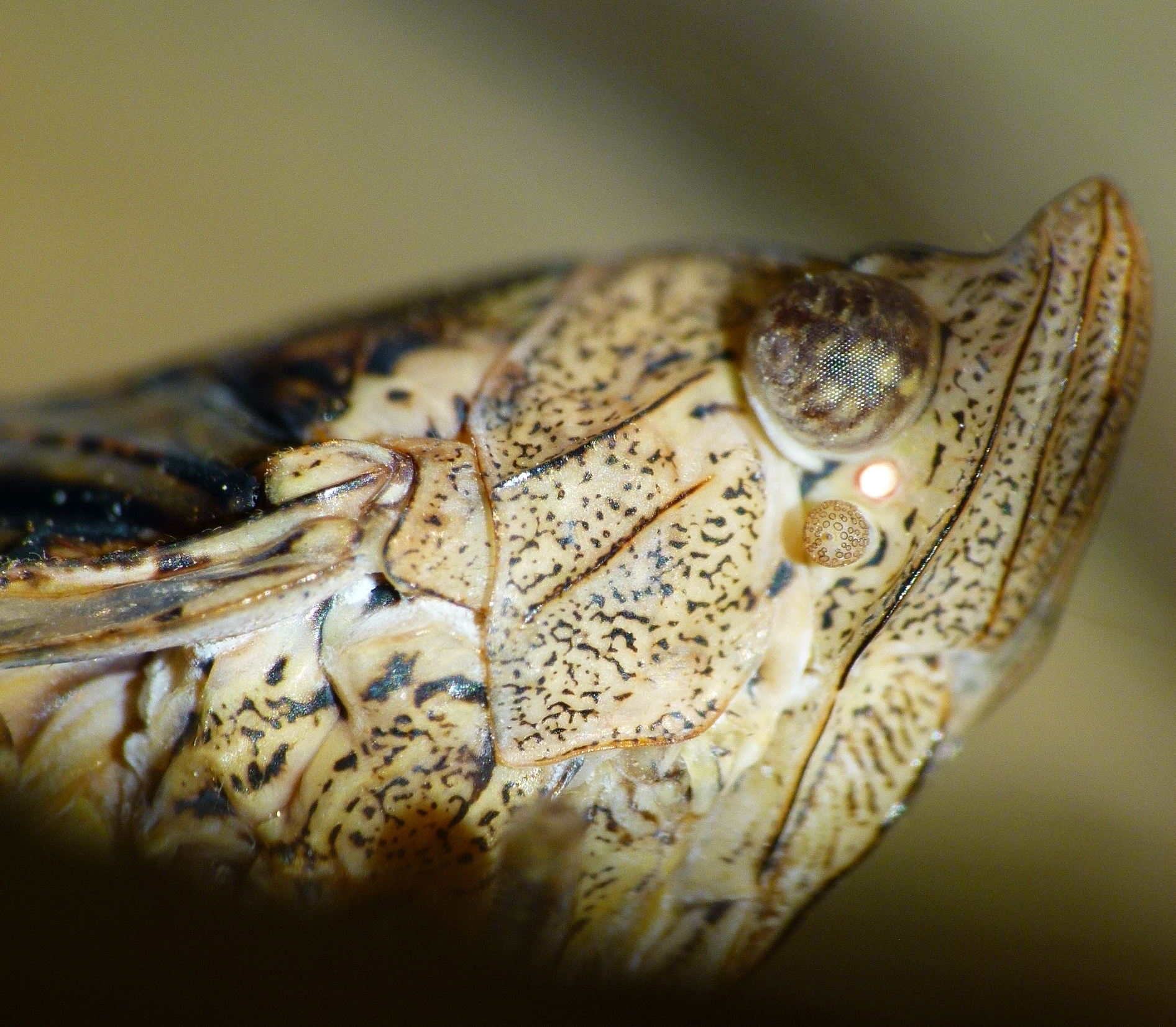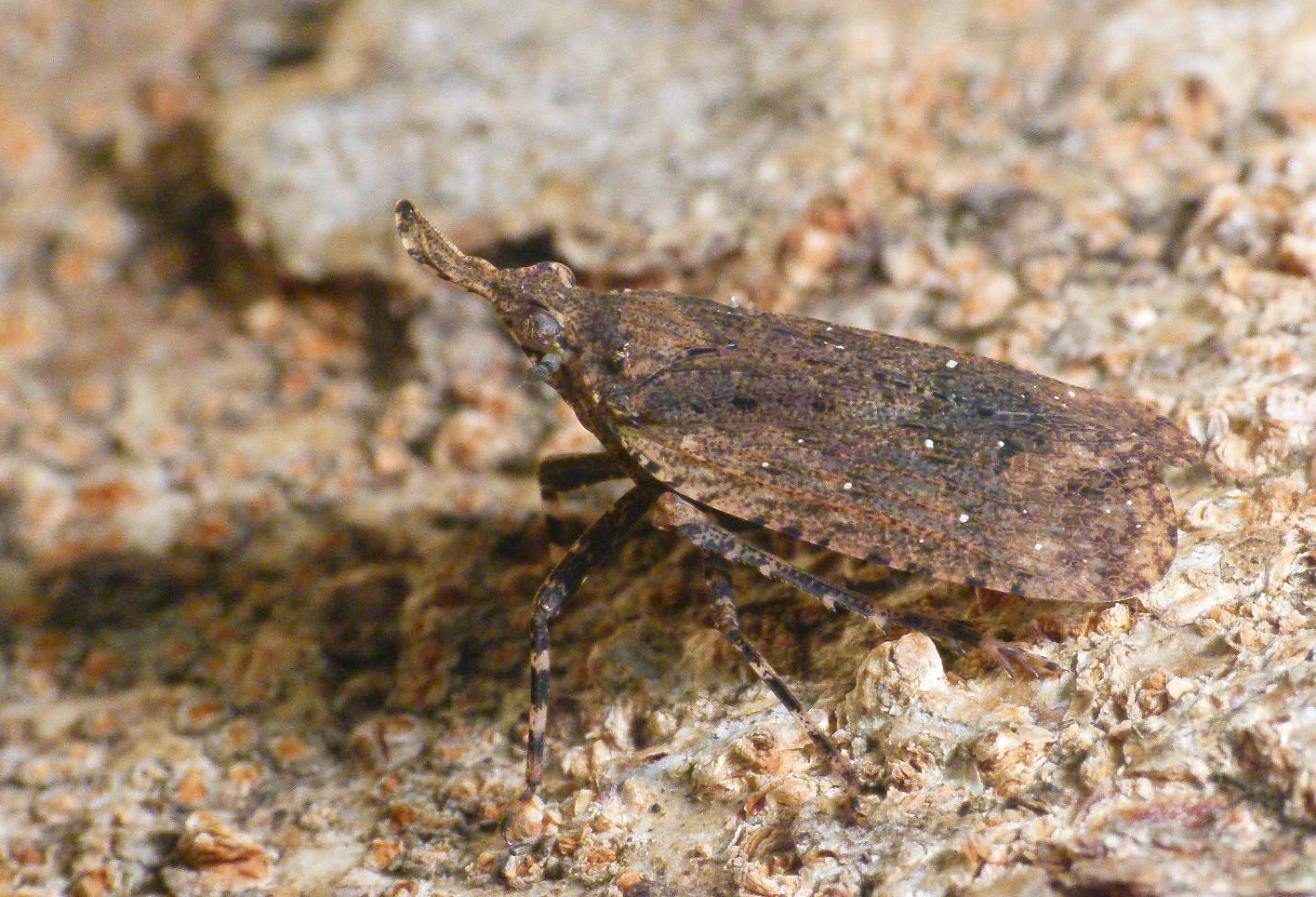|
Fulgoridae
The family Fulgoridae is a large group of hemipteran insects, especially abundant and diverse in the tropics, containing over 125 genera worldwide. They are mostly of moderate to large size, many with a superficial resemblance to Lepidoptera due to their brilliant and varied coloration. Various genera and species (especially the genera ''Fulgora'' and ''Pyrops'') are sometimes referred to as lanternflies or lanthorn flies. The head of some species is produced into a hollow process (anatomy), process, resembling a snout, which is sometimes inflated and nearly as large as the body of the insect, sometimes elongated, narrow and apically upturned. It was believed, mainly on the authority of Maria Sibylla Merian, that this process, the so-called lantern, was luminous at night in the living insect. Carl Linnaeus adopted the statement without question and coined a number of specific names, such as ''laternaria'', ''phosphorea'' and ''candelaria'' to illustrate the supposed fact, and thus ... [...More Info...] [...Related Items...] OR: [Wikipedia] [Google] [Baidu] |
Pyrops
''Pyrops'' is a genus of planthoppers that occur primarily in southeast Asia, containing about 70 species. They are fairly large insects, with much of the length due to an elongated, upcurving, snout-like projection of the head. The wings are generally brightly patterned in contrasting colors, and they are popular among collectors. Species The genus has been divided into several species groups: Candelaria group '' Pyrops lathburii'' *'' Pyrops aeruginosus'' (Stål, 1870) *'' Pyrops agusanensis'' (Baker, 1925) *'' Pyrops atroalbus'' (Distant, 1918) *'' Pyrops auratus'' Constant, 2021 *'' Pyrops azureus'' Constant & Mohan, 2017 *'' Pyrops buomvoi'' Constant & Pham, 2022 *'' Pyrops candelaria'' (Linnaeus, 1758) – type species *'' Pyrops coelestinus'' (Stål, 1863) *'' Pyrops condorinus'' (Lallemand, 1960) *'' Pyrops connectens'' (Atkinson, 1885) *'' Pyrops curtiprora'' (Butler, 1874) - Actually a ''Saiva'' species. *'' Pyrops delessertii'' (Guerin-Meneville, 1840) *'' Pyrops d ... [...More Info...] [...Related Items...] OR: [Wikipedia] [Google] [Baidu] |
Lycorma
''Lycorma'' is a genus of planthoppers native to Asia. The first species within the genus was described by Frederick William Hope in 1843 and the genus was formally established by Carl Stål in 1863. ''L. delicatula'', known as the spotted lanternfly, is an invasive species in the United States, Japan, and South Korea. Discovery and taxonomy The genus ''Lycorma'' is in the planthopper family Fulgoridae, subfamily Aphaeninae. Species within this genus are native to Asia. Frederick William Hope, in 1843, described ''Lystra punicea'', the first named species of the clade. In 1845, Adam White classified two new species under the genus '' Aphaena'', ''Aphaena imperialis'' and ''Aphaena delicatula''. White described the species as similar to '' Aphaena variegata'', another planthopper species native to Asia, and referenced prior descriptions by George Tradescant Lay in his initial classification of the lanternflies. Between 1846 and 1863, the species were reclassified by both J ... [...More Info...] [...Related Items...] OR: [Wikipedia] [Google] [Baidu] |
Aphaeninae
The subfamily Aphaeninae is a group of hemipteran insects, especially abundant and diverse in the tropics, in the family Fulgoridae, or "lanternflies". The future of the Aphaeninae as a subfamily is unclear since the taxa assigned to it do not form a monophyletic group in recent molecular analyses. The tribe Enchophorini, previously placed here, has been raised to a subfamily. Tribes and genera Recent research has resulted in the reclassification of the former tribe Enchophorini to a separate subfamily (e.g. ), while the tribe Pyropsini is now included here (e.g.,). Aphaenini Auth.: Blanchard, 1847 and Distant, 1906 (distribution: worldwide tropics) * ''Anecphora'' Karsch, 1890 (equatorial Africa) * ''Aphaena'' Guérin-Méneville, 1834 (type genus: Asia) * ''Calmar (planthopper), Calmar'' Kirkaldy, 1901 (Gambia) * ''Coelodictya'' Jacobi, 1910 (E. Africa) * ''Copidocephala'' Stål, 1869 (Central Americas) * ''Eddara'' Walker, 1858 (Sub-Saharan Africa) * ''Egregia (planthoppe ... [...More Info...] [...Related Items...] OR: [Wikipedia] [Google] [Baidu] |
Zanninae
''Zanna'' is a genus of tropical planthoppers (family Fulgoridae) found in Asia and Africa, now belonging to the monotypic subfamily Zanninae. Taxonomy The tribe Zannini previously contained other genera, but its placement was the subject to debate: it is now the only genus and placed in the Zanninae at the sub-family level. However, although currently placed in the family Fulgoridae, molecular studies question this placement, as the genus is sister taxon to the Dictyopharidae and Fulgoridae combined, rather than Fulgoridae alone. Description The forewings are bodies are mostly grey with black speckling, and they have a long head process with small lateral spines and some folds on the surface. Gallery Madagascan Leaf bug.JPG, ''Z. tenebrosa'' nymph Planthopper (Zanna madagascariensis) (8541686748).jpg, '' Zanna tenebrosa'', the type species of the genus; (Madagascar) Giant Lantern Bug (Zanna terminalis) (15357529400).jpg, ''Z. terminalis'' (Borneo) Lanternfly (Zanna serville ... [...More Info...] [...Related Items...] OR: [Wikipedia] [Google] [Baidu] |
Fulgorinae
The Fulgorinae are a sub-family of insects in the Auchenorrhyncha: which include the spectacular "lantern-bugs" and allied insects. Tribes and genera Nine genera are currently listed by the National Center for Biotechnology Information, NCBI, but molecular studies question the placement of genera in the Zannini, even questioning whether they belong to the family Fulgoridae. There have until recently been two tribes placed within Fulgorinae, but recent research suggests that the tribe Pyropsini should instead be placed within the subfamily Aphaeninae (e.g.,Jiaranaisakul, Kawin & Constant, Jérôme & Pinkaew, Nantasak. (2024). Review of the lanternfly genus ''Pyrops'' of Thailand (Hemiptera: Fulgoridae) with notes and keys to species. Zootaxa. 5397. 47-79. 10.11646/zootaxa.5397.1.3.), leaving only a single tribe, Fulgorini. Fulgorini Auth.: Latreille, 1807 (central and southern America) ;subtribe Fulgorina Latreille, 1807 # ''Cathedra'' Kirkaldy, 1903 monotypic: ''Cathedra serr ... [...More Info...] [...Related Items...] OR: [Wikipedia] [Google] [Baidu] |
Planthopper (Auchalea Pandora) (8350745330)
A planthopper is any insect in the infraorder Fulgoromorpha, in the suborder Auchenorrhyncha, a group exceeding 12,500 described species worldwide. The name comes from their remarkable resemblance to leaves and other plants of their environment and that they often "hop" for quick transportation in a similar way to that of grasshoppers. However, planthoppers generally walk very slowly. Distributed worldwide, all members of this group are plant-feeders, though few are considered pests. Fulgoromorphs are most reliably distinguished from the other Auchenorrhyncha by two features; the bifurcate (Y-shaped) anal vein in the forewing, and the thickened, three-segmented antennae, with a generally round or egg-shaped second segment (pedicel) that bears a fine filamentous arista. Overview Planthoppers are laterally flattened and hold their broad wings vertically, in a tent-like fashion, concealing the sides of the body and part of the legs. Nymphs of many planthoppers produce wax from ... [...More Info...] [...Related Items...] OR: [Wikipedia] [Google] [Baidu] |
Dichoptera2
''Dichoptera'' is a genus of planthoppers found in tropical Asia. They were formerly placed in the family Dictyopharidae but are now considered members of the family Fulgoridae The family Fulgoridae is a large group of hemipteran insects, especially abundant and diverse in the tropics, containing over 125 genera worldwide. They are mostly of moderate to large size, many with a superficial resemblance to Lepidoptera due t .... They have large and stout bodies with long membranous forewings. The head is short and may have a long process. There are 11 species in the genus. Often found on the bark of ''Ficus'' trees, they are tended by ants and sometimes parasitized by Dryinidae. References Fulgoridae Auchenorrhyncha genera Taxa named by Maximilian Spinola {{Fulgoridae-stub ... [...More Info...] [...Related Items...] OR: [Wikipedia] [Google] [Baidu] |
Polydictya Uniformis TPopp
''Polydictya'' is a genus of planthoppers in the sub-family Poiocerinae Haupt, 1929. Species are distributed from India, through Indo-China, to Malesia Malesia is a biogeographical region straddling the Equator and the boundaries of the Indomalayan and Australasian realms. It is a phytogeographical floristic region in the Paleotropical kingdom. It was first recognized as a distinct region .... Species The following described species are accepted: # '' Polydictya affinis'' Atkinson, 1889 # '' Polydictya bantimurung'' Constant, 2015 # '' Polydictya barclayi'' Constant, 2016 # '' Polydictya basalis'' (Hope, 1843) - type species # '' Polydictya basirubra'' Constant, 2015 # '' Polydictya bhaskarai'' Constant, 2024 https://www.researchgate.net/publication/380743680_Polydictya_lanternflies_of_Java_New_species_taxonomy_and_identification_key_Hemiptera_Fulgoromorpha_Fulgoridae # '' Polydictya chantrainei'' Nagai & Porion, 2004 # '' Polydictya chewi'' Nagai & Porion, 2004 # '' P ... [...More Info...] [...Related Items...] OR: [Wikipedia] [Google] [Baidu] |
Alcathous (planthopper)
''Alcathous'' is a monotypic genus containing the species ''Alcathous fecialis'': a fulgorid planthopper, in the subfamily Amyclinae and found in southern India South India, also known as Southern India or Peninsular India, is the southern part of the Deccan Peninsula in India encompassing the states of Andhra Pradesh, Karnataka, Kerala, Tamil Nadu and Telangana as well as the union territories of .... It is predominantly brown with dark markings. Its snout curves slightly upward, and its wings are about 3 cm long and hide its short abdomen. From its eyes to the tip of its abdomen, ''A. fecialis'' is about 1.2 cm long with a 0.3 cm snout. References Insects of India Auchenorrhyncha genera Fulgoridae Taxa named by Carl Stål {{Fulgoridae-stub ... [...More Info...] [...Related Items...] OR: [Wikipedia] [Google] [Baidu] |
Poiocerinae
The subfamily Poiocerinae include Hemipteran insects in the family Fulgoridae, found especially in the tropics. Tribes and genera The ''Fulgoromorpha Lists On the Web'' (FLOW) includes four Tribe (biology), tribes: Diloburini Auth. Metcalf, 1938 (central & South America) * ''Aracynthus (planthopper), Aracynthus'' Stål, 1866 * ''Dilobura'' Spinola, 1839 * ''Echetra'' Walker, 1858 * ''Episcius'' Spinola, 1839 * ''Japetus (planthopper), Japetus'' Stål, 1863 * ''Obia (planthopper), Obia'' Distant, 1887 * ''Zepasa'' Distant, 1906 Lystrini Auth. Spinola, 1839 - Americas * ''Lystra (planthopper), Lystra'' Fabricius, 1803 * ''Lystrenia'' Fennah & Carvalho, 1963 Paralystrini Auth. Metcalf, 1938 (South America) * ''Paralystra'' White, 1846 Poiocerini Auth. Haupt, 1929 (Americas, Asia, Australasia; former subtribes no longer recognizedYanega, D., Goemans, G., Van Dam M., Gómez-Marco, F., Hoddle, M. (2024) Description of a new genus of North and Central American planthoppers ... [...More Info...] [...Related Items...] OR: [Wikipedia] [Google] [Baidu] |
Fulgora
The fulgorid genus ''Fulgora'' contains several large Central and South American planthoppers known by a large variety of common names including lantern fly, peanut bug, peanut-headed lanternfly, alligator bug, machaca, and jequitiranaboia (the latter terms used in the Amazon region and elsewhere in Brazil). Species Species are mostly similar in appearance, with differences in the shape of the head (often quite subtle), and patterns of wing coloration; there is some confusion regarding the validity of some of the currently recognised species. Some individuals can measure up to 75 mm (3 inches). The type species of ''Fulgora'' is ''Cicada laternaria'' Linnaeus 1758, designated under the Plenary Powers by ICZN (1954185; now '' Fulgora laternaria'', it is the most well-known and widespread species. ''Fulgoromorpha Lists On the Web'' includes: # '' Fulgora caerulescens'' Olivier, 1791 # '' Fulgora castresii'' Guérin-Méneville, 1837 # '' Fulgora cearensis'' (Da Fonseca ... [...More Info...] [...Related Items...] OR: [Wikipedia] [Google] [Baidu] |



